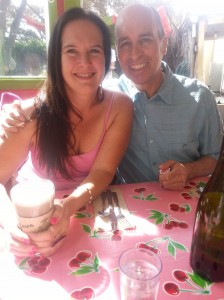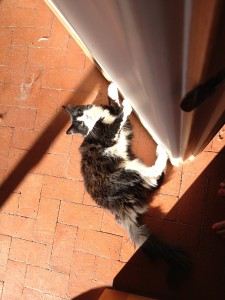 During my travels last week, I stayed with a friend of many years, Kristine Krantz (aka KAK). She blogs on the Word Whores with me and also writes fantasy. We met via the RWA online chapter FF&P, sometime back in the vicinity of 2009. We became critique partners and friends.
During my travels last week, I stayed with a friend of many years, Kristine Krantz (aka KAK). She blogs on the Word Whores with me and also writes fantasy. We met via the RWA online chapter FF&P, sometime back in the vicinity of 2009. We became critique partners and friends.
At that time, we were both in the same place – shopping these fantasy novels we’d written and hoped to sandwich into some pre-cut genre somewhere. Though my path was hardly a straight-line – no A-ticket Cinderella ride for me – mine has gone faster than hers. She’s still “pre-pubbed” or whatever euphemism you’d like to slap onto that vicious purgatory of waiting for the market to catch up to your genius. I know this is a hard place to be, because I’ve been there. Another friend and sister Word Whore, Allison Pang, who I met at the same time and in the same way, also shopping a like novel, did manage to pull the A-ticket and full Cinderella ride.
(The moral of our three paths, by the way, is that none is strewn with rose petals and nobody, so far as I know, has received a sparkle pony life companion.)
At any rate, (I’m sure by now KAK has scanned ahead to find out just what the hell I plan to say about her) KAK invited me to stay at her house while I attended the Lori Foster Reader & Author Get Together. This turned out to be an unexpected delight because we spent many hours on her delicious screened back porch, overlooking her park-like back yard, while we worked on writerly things and talked.
There’s something truly restorative about rambling conversations on writing and publishing with like-minded friend who’s as keenly interested in the minutiae as you are. Though we see each other on IM, the conversations only go so far. I also realized, as we talked, that I haven’t been updating her regularly on all of my “business.” It’s a funny thing – as you get into dealing with Published Author World, you tend to talk most to people in the same tangle. I don’t *think* I ditched my pre-pub buddy, but we’ve been working on really different things. And, as you faithful readers know, my life has been moving really fast lately.
In fact, she FINALLY (hee hee hee) completed a monstrous revision of her epic fantasy novel. “Revision” is probably a misnomer because she really wrote a whole new novel with the same world and characters. I feel quite a bit of guilty responsibility for this since I was the one to give the crit that triggered the massive rewrite.
She says she doesn’t blame me.
But it took her a long time to do this. Meanwhile I’ve been working fast. It’s nice for her to be able to do this, because she has the luxury of time right now. We know you pre-pub authors get sick of hearing this from us – we got sick of hearing it, too – but writing before contract is REALLY different than writing for contract and under deadline. We know it’s not nostalgia-worthy since being in that hem-tugging, please-see-me stage of publication wears on the soul, but having the luxury of time is something we look back on fondly. Also the lack of expectations.
KAK and I had this conversation. She mentioned that she’d noticed me blogging about writing books I sold on spec and how it feels different. I said, yes, that it feels like another kind of writing altogether. For me it means:
- I have to form a plan ahead of time, because selling on spec means I sell the concept and THEN write the book. This is not a natural pattern for me.
- Writing a story you’ve “pre-sold” to an editor creates this lens where I feel like I’m writing FOR the editor. That person is very firmly in my mind, because they are now the primary recipient of my story. I haven’t decided if this is good or bad.
- There is a firm external deadline. I have to plan ahead – by a year or more, in some cases – to ensure I have the time to write and revise the way I want to.
This last is crucial because, as I rambled on the topic, KAK nodded and said, yes, you write faster and cut out the art.
Which I’ve been mulling ever since.
Because I don’t think that’s true. I can totally see why it would seem that way. There is certainly not the time to lovingly tweak and polish every bit. There is, also, a definite sense of creating a product that fits a particular expectation (see #2 above). However, I don’t feel like I’m cutting out the art.
Maybe this is self-delusion, because I really HOPE I’m not cutting out the art.
I definitely have not managed to short-cut the suffering. Writing a book faster is no less painful than writing it slowly. It’s more that I am more efficient about it. Some of this is experience. I know by now where I’m going to bog down and how I’m going to feel about it – and I’m quite a bit more ruthless about pushing through it. I don’t have time to wander for weeks through the Enchanted Forest (see last Friday’s post, if you have no idea what I’m referring to). I’ve BEEN through that stinking forest and now I just take the direct – and sometimes arduous – path straight through to the Fountain of Story.
I think it’s less cutting out some of the art and more knowing how to pack the art in there. Like really experienced travelers can pack for a two-week trip in 30 minutes and not forget a thing. You just get good at it.
Mainly because you have to.
Speaking of which, I have a novella due on Saturday and just shy of 9K to go to finish.
See you on the flip side!








